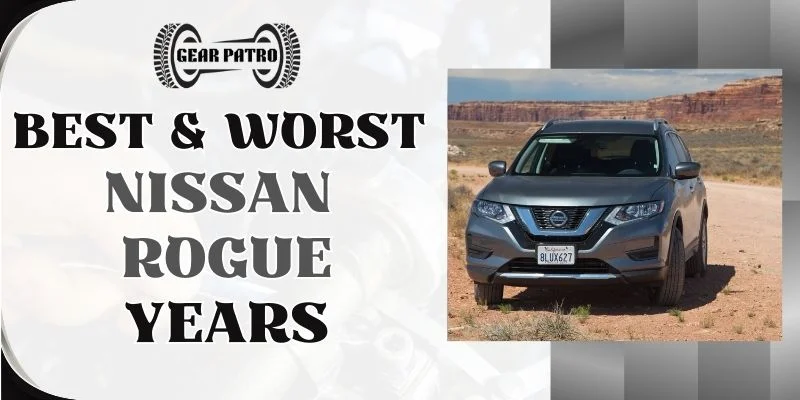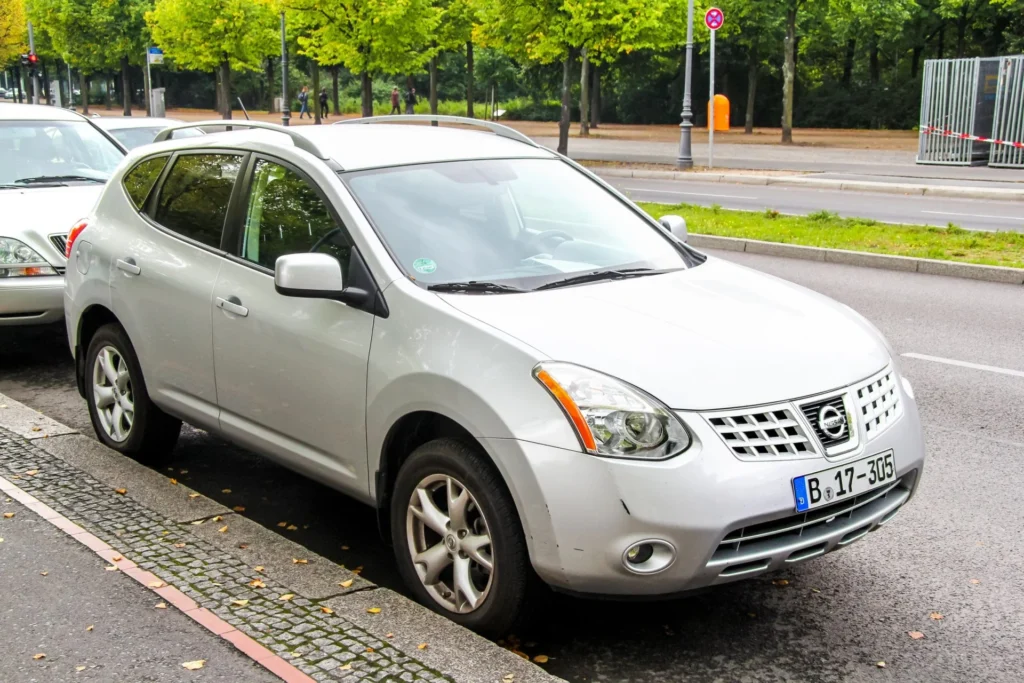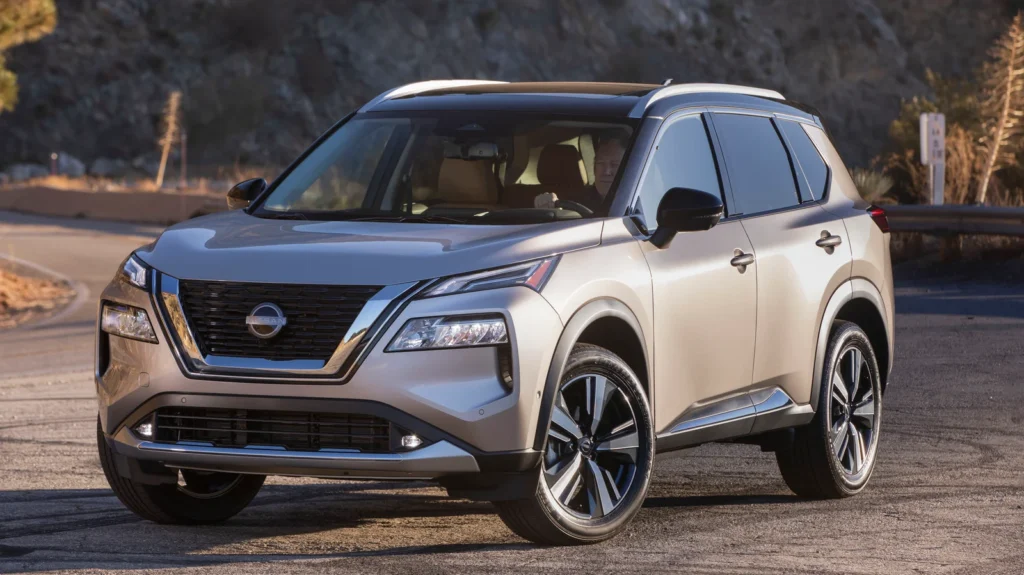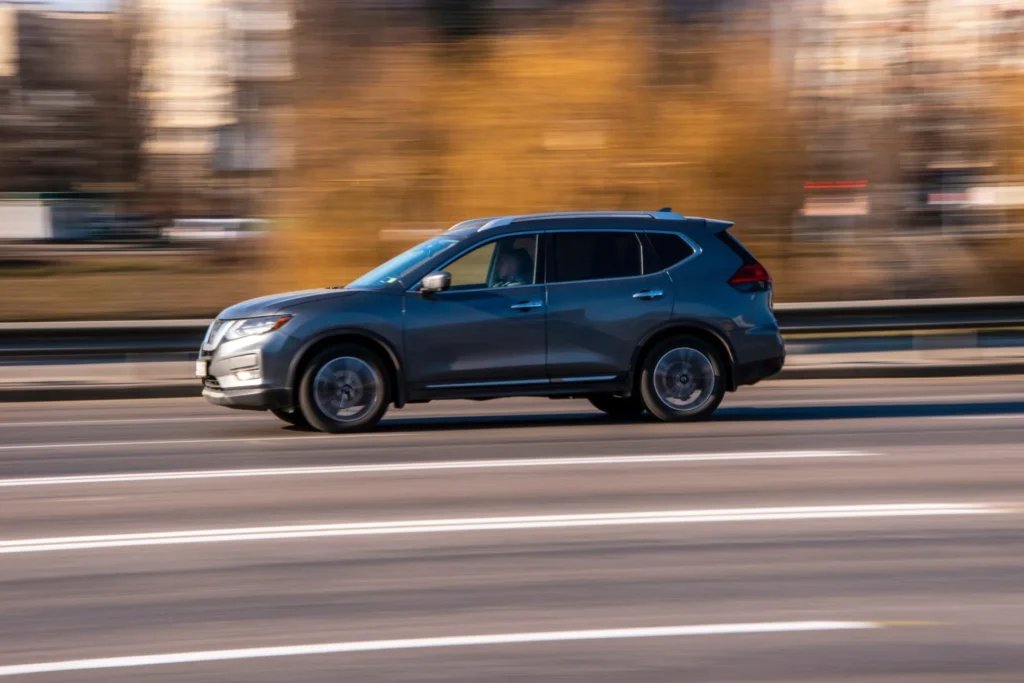Each Nissan Rogue model has been ranked for every generation, so you don’t have to pick the worst Nissan Rogue year.
You will learn which Nissan Rogue years are best and worst to buy in this guide.
Our Nissan Rogue model year breakdown is built on credible data sourced from reputable sources including the NHTSA, VehicleHistory, and Consumer Reports.

Discover more about Nissan Rogue’s various generations, powertrain options, safety features, and resale values.
Let’s get started!
Nissan Rogue Generations
In 2008, Nissan introduced its first generation of the Rogue, a compact crossover. Smooth ride, comfortable interior, and user-friendly features were praised for the initial model.
In order to remain at the forefront of its segment, Nissan’s Rogue has gone through several evolutions.
Here is a table summarizing all Nissan Rogue generations since 2008:
| Generation | Years |
| 1st generation (S35) | 2008-2013 |
| 2nd generation (T32) | 2014-2020 |
| 3rd generation (T33) | 2021-Present |
Prospective buyers can pinpoint which models fit their needs and preferences if they know the generational shifts such as design updates, technological enhancements, and sometimes even changes in driving dynamics.
Nissan Rogue Best, Neutral, and Worst Years
Whenever we assess the best and worst Nissan Rogue years, we consider a broad range of factors. Among them are:
Here’s a table that categorizes Nissan Rogue model years based on the data collected into best, neutral, and worst years.
| Generation | Best Years | Neutral Years | Worst Years |
| 1st generation (S35) | 2011 2012 | N/A | 2008 2009 2010 2013 |
| 2nd generation (T32) | 2019 2020 | 2017 2018 | 2014 2015 2016 |
| 3rd generation (T33) | 2022 2023 | N/A | 2021 |
In comparison with other years, “Neutral Years” perform averagely, neither exceeding nor lagging significantly.
An automobile’s rating can be negatively impacted by certain factors, especially recalls issued by the NHTSA. It is more likely that reliability issues are present when there are more complaints and recalls.
Here’s a look at the Nissan Rogue’s best, neutral, and worst years.
Best & Worst Nissan Pathfinder Years | Years To Avoid
Best & Worst Years for Nissan Rogue 1st Generation (2008-2013)
The Nissan Rogue was launched in 2008 with a goal of capturing the compact crossover SUV market, combining the robustness of an SUV with the agility of a compact car.

In spite of the fact that 2011 and 2012 are Nissan Rogue’s best years in this generation, we recommend thorough transmission checks because of widespread transmission problems.
The Best Years: 2011, 2012
According to NHTSA, 2011 and 2012 were the best Nissan Rogue years to buy in the first generation, based on fewer reported grievances and recalls from owners.
With the 2.5L QR25DE engine mated to a CVT (Continuously Variable Transmission), the Rogue produced 170 horsepower and 175 lb-ft of torque in 2011 and 2012.
It achieves an estimated 22 miles per gallon in the city and 28 miles per gallon on the highway.
Additionally, enhanced trim levels were introduced during these years. Many preferred the SV trim because it was equipped with a rearview camera, a premium audio system, and keyless entry.
As a result of jerking and slipping, the CVT transmission continued to be a source of complaints.
The Worst Years: 2008, 2009, 2010, 2013
According to our investigation of owner complaints and recalls on NHTSA, CVT transmission issues were most prevalent in 2008, 2009, 2010, and 2013. Some cases even resulted in transmission failure.
It was expected that these issues would have been resolved by 2013, but the transmission issues have resurfaced disappointingly.
These recalls addressed various concerns, including possible electrical shorts due to water intrusion, and loose steering gear housings.
Due to these issues, particularly the unaddressed transmission problems, Nissan Rogue years 2008, 2009, 2010, and 2013 are the least recommended.
Nissan Rogue recalls and complaints from 2008, 2009, 2010, and 2013.
Best & Worst Years for Nissan Rogue 2nd Generation (2014-2020)
The Nissan Rogue matured with new aesthetics and technology in its second generation in 2014, targeting a broader market for compact SUVs.

Nissan Rogue’s best years are 2019 and 2020, while 2014-2016 Nissan Rogue models are best avoided.
The Best Years: 2019, 2020
Which Nissan Rogue year is the best? In the second generation of the Nissan Rogue, 2019 and 2020 were arguably the best years.
With a 2.5L QR25DE four-cylinder engine and CVT transmission, these Rogues produced 170 horsepower.
It averaged 26 city/33 highway miles per gallon, which is commendable.
Furthermore, these models were available in a variety of trim levels. In addition to ProPILOT Assist, Apple CarPlay, and Android Auto integration, the SV and SL trims boasted advanced safety features.
Although less frequent than their predecessors, these models weren’t completely free of transmission-related complaints.
The Neutral Years: 2017, 2018
In 2017 and 2018, the Rogue went through a transitional period.
Power delivery and efficiency refinements began to emerge despite still housing the 2.5L engine and CVT.
With updates to infotainment, they made strides in technological advancement.
In spite of this, some previous electrical issues prevented them from reaching the tier of “best Nissan Rogue years”.
The Worst Years: 2014, 2015, 2016
Nissan Rogue’s second generation is undeniably in its worst form in 2014, 2015, and 2016, so avoid them at all costs.
Reports of burning odors, defective wiring, and stalling engines were common on Nissan Rogue models from 2014 through 2016.
As with the first generation CVT transmission, there were still issues with the transmission.
These years were marked by numerous recalls, including corrosion in under-dash electrical connectors, water-seepage-induced electrical shorts, and improperly plated fuel pumps that cause engine stalls.
Additionally, the 2015 Nissan Rogue was recalled due to an unintentional shifter that could cause the vehicle to rollaway.
NHTSA recalls and complaints for the Nissan Rogue for 2014, 2015, and 2016.
Best & Worst Years for Nissan Rogue 3rd Generation (2021-Present)
The third generation of the Rogue, introduced in 2021, marked a new beginning for Nissan in the compact SUV segment. Performance and luxury were balanced in this generation with bolder aesthetics and tech-forward features.

While 2022 and 2023 are Nissan Rogue’s most reliable years in this generation, 2021 has numerous recalls concerning various mediums, so avoid 2021 Nissan Rogue models.
The Best Years: 2022, 2023
As the Nissan Rogue’s generation progresses, new aesthetics and features will be available for 2022 and 2023.
A 2.5L four-cylinder engine coupled with an Xtronic CVT delivers 181 horsepower in these models.
Fuel efficiency is outstanding, with an estimated 30 mpg in urban areas and 37 mpg on the highway.
Platinum trim combines luxury elements previously unavailable in Rogues, making it a notable highlight of these years.
With a larger 9-inch touchscreen, ProPILOT Assist with Navi-link, and wireless Apple CarPlay integration, these models are unlike anything else on the market.
The Worst Years: 2021
Nissan Rogue’s worst year of the third generation – 2021, received many recalls for fuel pumps, rearview displays, brakes, and other issues.
Several electrical malfunctions and fuel odors were reported inside the cabin during this model year.
Its debut was clouded by a number of recalls, including issues with inoperative rearview displays, possible fuel pump overheating, which could cause engine stalls, fuel leaks from hoses, and even concerns about brake calipers lacking internal bushings, which compromised braking performance.
The Nissan Rogue third generation should be avoided in 2021 based on these facts.
Common Nissan Rogue Problems
Nissan’s Rogue crossover SUV is a reliable choice, but some years come with glaring problems.
Best & Worst Nissan Frontier Years | Years To Avoid
Best & Worst Nissan Pathfinder Years | Years To Avoid
Best & Worst Nissan Sentra Years | Years To Avoid
FAQs: Nissan Rogue Years to Avoid
Which Nissan Rogue years should I avoid?
In accordance with the guide above, Nissan Rogue models from 2008 to 2016 and the 2018 model should be avoided. It has been identified that vehicles from these years have significant transmission defects, which can be quite a hassle to fix.
Did any of the Nissan Rogue years to avoid have other significant issues?
Air conditioning units and interior accessories were also problematic on the 2014 and 2015 models. As well as suspension problems, the 2016 model had serious brake issues, including sudden and unintended braking.
Are newer Nissan Rogue models more reliable?
There have been almost no complaints concerning the newer Nissan Rogue models, specifically the 2019 models, 2020 models, 2021 models, and 2022 models. Over the years, Nissan has improved the design and construction of these models, and it has addressed many issues that were previously present.
Is the Nissan Rogue a good car to purchase?
Nissan’s Rogue compact crossover SUV has suffered reliability issues in some model years, but is generally reliable and popular. The Nissan Rogue is a good buy when you avoid the problematic years and choose models with a better track record.
Conclusion
The 2019 and 2020 Nissan Rogue models are clearly the best years, with fewer reported issues and recalls, while the 2008-2010 and 2013-2016 Nissan Rogue models should be avoided.
Does your experience match our findings regarding the best or worst Nissan Rogue years?
Comment below with your thoughts!
